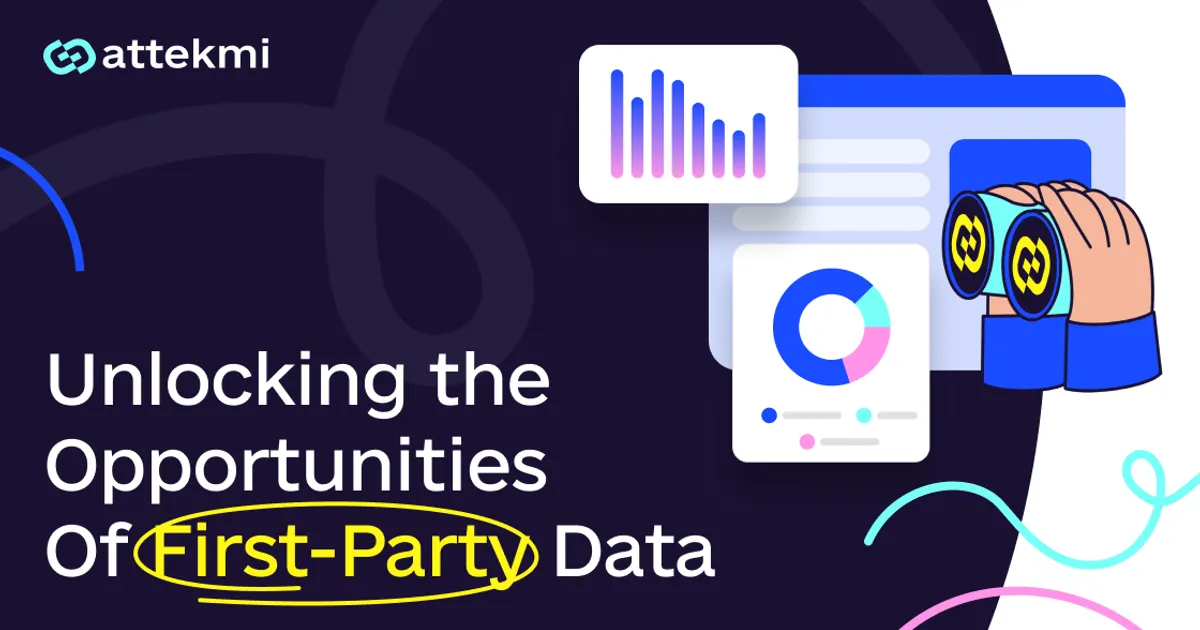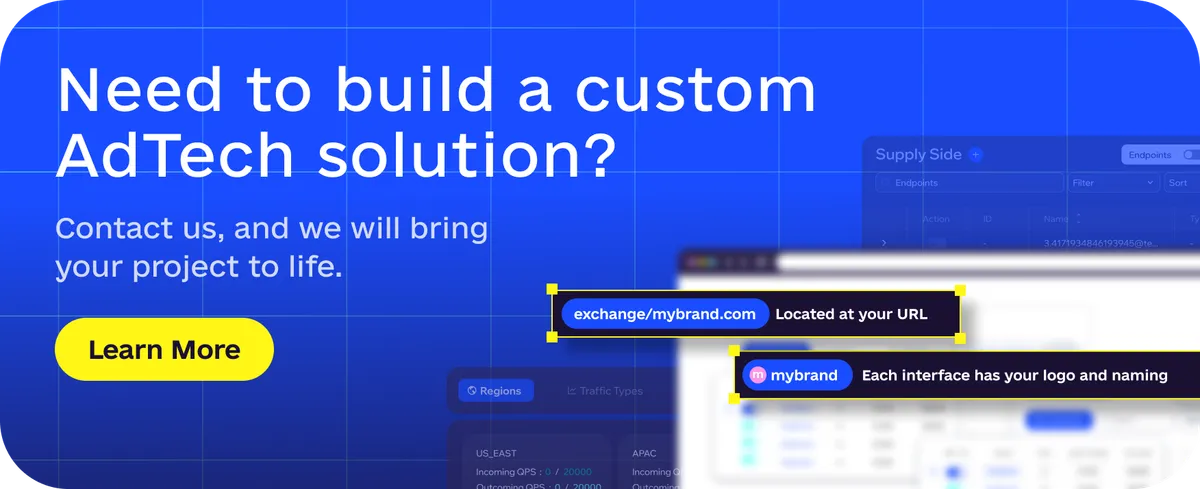In the modern digital world, privacy plays a more crucial role than ever. While customers are getting more and more concerned about the usage of their data, international standards and regulations are getting stricter. As a result, using first-party data instead of relying on third-party cookies becomes a must. But how to create a first-party data strategy? What are the benefits of doing so?
Operating in the programmatic industry since 2018, we know everything about AdTech. To help you adapt to the privacy-first reality, we have prepared this guide providing all the information you need regarding first-party data. Keep reading to discover how to optimize your strategy.
Key Takeaways:
First-party data is the most valuable and reliable type of data, as you collect it directly from your customers.
In the privacy-first world, adopting a first-party data strategy is a must.
Ensuring transparency is one of the key elements – this helps you build trust and collect the data you need.
A customer data platform allows you to unify the data from multiple sources and maximize the effectiveness of your strategy.
What is first-party data and why does it matter?
First-party data is the data you collect directly from your customers via your owned channels: your website, app, social media accounts, email newsletters, etc. In addition, this type of data can be collected through transactions, surveys, and forms. Such data can include browsing behavior, purchase history, names, phone numbers, emails, transcripts from support tickets, and more specific details (like those you can collect through surveys).
Here are the reasons why first-party data matters:
Since this data is collected directly from customers, it is more reliable, accurate, and valuable.
With first-party data, you can deliver more personalized experiences to your customers and build more trusted relationships with them.
First-party data allows you to improve targeting.
Switching to first-party data is a way to remain credible and compliant with relevant regulations.
If your competitors prefer third- or second-party data, using first-party data can provide you with a significant competitive advantage.
How programmatic platforms use first-party data
Demand-side platforms (DSPs), supply-side platforms (SSPs), and ad exchanges are key elements of the programmatic ecosystem. Let’s review how they use first-party data.
DSPs
For effective programmatic advertising, DSPs are often integrated with customer data platforms (CDPs) that advertisers leverage to unify first-party data. Besides, marketers can utilize such data when setting up their campaigns on DSPs. Then, DSPs use the provided data to identify the most relevant ad inventory and bid on it.
SSPs
For SSPs, the scenario is pretty much the same. Data is used for targeting; however, while advertisers aim to reach those customers who are most likely to get interested in their products or services, publishers strive to provide their website visitors or app users with relevant experiences and maximize revenue.
Ad exchanges
Using first-party data, ad exchanges ensure relevant connections between advertisers and publishers. As a result, marketers purchase the required inventory, while publishers display advertisements that their users are most likely to appreciate.
How to build a first-party data strategy
To build a first-party data programmatic advertising strategy, you need to take the following steps:
1. Decide on your goals
As usual, the first thing to do is to define your goals that will guide your strategy – for instance, this can be increasing conversion rates. Make sure to keep your goals SMART: specific, measurable, achievable, relevant, and time-bound. Such well-defined objectives will enable you and your team to move in the right direction.
2. Identify relevant metrics and the required data sources
Then, you need to select metrics reflecting the outlined goals and decide how exactly you will measure your success. How will you analyze the impact of your strategy? Keep in mind that you may need to partner with an experienced technology provider offering advanced analytics capabilities.
Besides, you need to identify the most valuable data sources. What are your existing sources? Are there any options that can boost your first-party data strategy? For instance, you may want to launch a loyalty program or enable customers to create accounts on your website.
3. Ensure transparency
Transparency is key to effective first-party data collection – your audience must feel comfortable when sharing their information with you. Therefore, provide clear policies. Explain to customers what data you collect and how you are going to use it, and do this in a clear and simple language. Besides, communicate the benefits customers will get in exchange for their information: improved customer service, enhanced product features, personalized offers, and so on.
Keep in mind that requesting too much information, asking to share the data in an intrusive manner, and misusing customer data are things that you should avoid. Such issues can affect customer experience and prevent you from building trust.
4. Collect the data
The effectiveness of your 1st-party data strategy relies not only on the data you will collect after defining the goals and taking all the other steps mentioned above. You also need to gather the data from across your enterprise, so review the current information that you have and make sure to unify it. Instead of keeping the data isolated in different systems, you need to make it centralized.
5. Create a customer journey map
A detailed customer journey map enables you to understand the steps users take between the first interaction and conversion, define touchpoints for data collection, segment the audience, and ensure greater personalization of your marketing efforts. Therefore, explore how your customers move through the funnel – this will allow you to engage them in a more effective way.
6. Invest in an effective CDP
Customer data platforms help integrate data from multiple sources, so consider investing in such a solution to maximize the effectiveness of your strategy.
In case you need to create a unique CDP, keep in mind that Attekmi offers custom AdTech development services. Our skilled team has extensive experience with AdTech solutions and is ready to help your business reach new heights.
Key challenges in building a first-party data strategy
To ensure the success of your first-party data advertising strategy, you need to understand the challenges that may arise, as well as the ways to solve or prevent them from happening. Let’s review the most common issues.
A challenge | A solution |
The lack of a unified customer view | Getting a CDP to centralize the data |
Privacy regulations issues | Implementing clear data policies |
Collecting surface-level data | Conducting surveys to gather as much specific information as you can |
Scalability | Choosing the right solution |
Data quality | Continuous maintenance |
The lack of a unified customer view
To reach your goals effectively, you need to have a unified customer view, which, in turn, requires unified data. In case the data is stored across an entire range of separate databases, it can be challenging to unify the view, as well as integrate the data with the existing systems. To solve this issue, you need to establish clear data sharing protocols between different teams and get a customer data platform that would help you centralize the data.
Privacy regulations issues
Obviously, collecting first-party data is a much more privacy-friendly approach than using third-party cookies. However, there are still different standards and regulations to consider, and being compliant with them is a must to build trust and remain competitive. Therefore, come up with clear data standards and processes for data collection, storage, and usage. Besides, implement consent management solutions to ensure transparency (your solution should also be compliant with standards like GDPR and others).
Collecting surface-level data
Keep in mind that first-party data refers not only to email addresses and phone numbers. This can be any information your customers provide you with: their hobbies, languages, clothing sizes, and so on. If you limit yourself to collecting only basic data, your whole strategy will be rather superficial.
To ensure ultimate personalization, collect as much information as you can: ask your customers to fill in surveys (you may offer an incentive in exchange, e.g., a promo code), interact with them on social media, and so on. The more you know about your customers, the better.
Scalability
Your strategy must be scalable and ready to handle large amounts of data. Otherwise, it can be challenging for your operations to grow as the quantity of data increases. Therefore, when choosing a data storage solution, prefer the option that features ultimate scalability.
Data quality
Inaccurate, incomplete, or outdated data can negatively affect your marketing efforts. Apart from centralizing the data, you need to make sure that there are no gaps and maintain its quality continuously. Invest in training, so that all the team members will learn how to choose the selected solutions and ensure data quality.
Keep in mind that it may be effective to invest in your own AdTech solution that will help you bring your first-party strategy to life and meet all your requirements regarding scalability and quality maintenance capabilities.
Need a custom AdTech product? Learn More.
How Attekmi helps you activate and scale first-party data
At Attekmi, we offer a range of ad exchange solutions that is able to meet any needs:
AdEx Basic: an entry-level platform.
AdEx Plus: an enhanced version of AdEx Basic.
AdEx Enterprise: a solution with advanced functionality and ultimate scalability.
White Label Ad Exchange: a fully customizable platform, from UI personalization to custom on-request feature development.
But that’s not all. Our experienced team is ready to build a custom AdTech solution for you: a CDP, a DMP, a DSP, etc. Here are the benefits you can count on:
Extensive experience: we have been operating in the industry since 2018.
An individual approach: we prepare a strategy tailored to your specific needs and are always ready to adapt to your changing requirements.
Outstanding support: we are here to help you with any challenges.
Seamless integration: your custom solution will smoothly integrate into your processes.
FAQ
Investing in a customer data platform (CDP) is a crucial step in building a first-party data strategy. The effectiveness of a strategy requires unifying the data from multiple sources, and a CDP allows for doing this.
Yes. Such an approach enables you to fill the gaps and get a more comprehensive understanding of your customers. However, first-party data is still considered the most reliable and valuable.
Everything depends on your goals and other conditions, such as the current technological infrastructure, the data you have at the moment, etc. For instance, if you already have a CDP platform, implementing a strategy will take less time since you will not have to search for a solution and educate your team on how to use it.
 By Iryna Kozirevych
By Iryna Kozirevych

